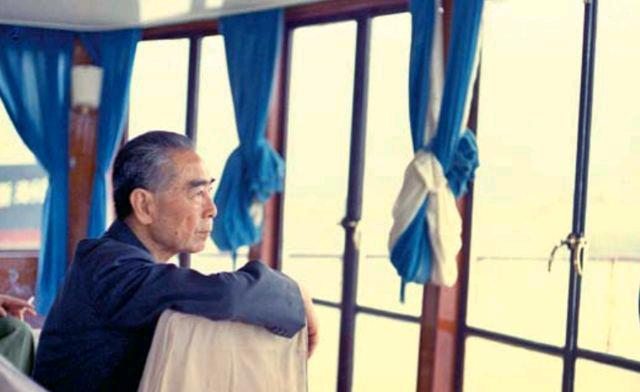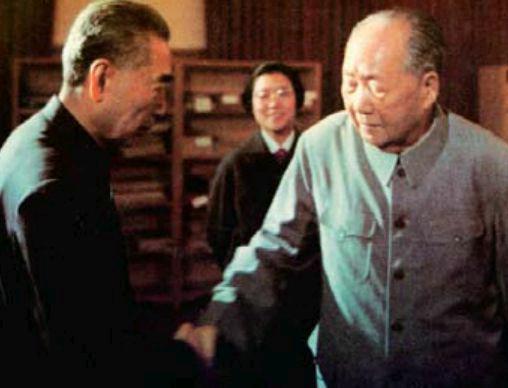Time Tracks You Down
2015-03-16
In a flash, it was October 1973, and the autumn sky was clear and the air crisp. Feeling much better, Zhou Enlai decided to accompany Pierre Elliott Trudeau, prime minister of Canada, to visit Luoyang.
The special train arrived at Luoyang Railway Station on time at 11:30 a.m. on October 14, and the tour group was welcomed by crowds of dressed-up locals.
Premier Zhou tired easily since he contracted cancer. Losing weight day by day, he always controlled himself and pretended to be normal in public. Though exhausted throughout the trip, he smiled and waved to the crowds as soon as he deboarded the train and shook hands with provin- cial and municipal officials as usual, expressing enthusiasm and sincerity with eye contact and powerful hand-shaking.
According to etiquette, Premier Zhou escorted Trudeau to his room at the Friendship Hotel in Luoyang before he went to his own room. In the hallway, Zhou noticed withered flowers and asked about them.
“Its a peony, sir,” someone replied.
“Peony? Oh. When does it bloom?”
“Late April and early May, sir.”
“So this is not the right season, huh? Ill be back on Labor Day (May 1) next year!”
There were countless“things to be done” in his head, yet he was not aware that serious illness had stricken him mercilessly.
In the afternoon, photographer Du Xiuxian took his camera and followed Zhou as he visited Longmen Grottoes, a renowned hub for the art of stone carving.
Longmen is located along the banks of the Yishui River, 12.5 kilometers south of downtown Luoyang. Highlighting green mountains which flank the Yishui River flowing south, the grottoes compose a spectacle reminiscent of an imperial palace from the distance, hence the name “Yi Palace.”More than 2,000 grottoes, big and small, were dug into the mountains during the Northern Wei (386-534), Tang (618-907) and Song (960-1279) dynasties. Longmen Grottoes have long been a tourist attraction, with a preservation of over 100,000 Buddhist statues and 3,600 pieces of statue inscriptions and inscriptions on stone tablets.
After getting out of the car, Zhou shielded his eyes from the sun with a hand and looked around: On one side was the rippling river and on the other were the grottoes. Indeed, Zhou had never seen any ruins as beautiful and elegant as these. He couldnt help but smile, finally relaxing amidst his busy work schedule. His eyes shined upon seeing the splendid nature of mountains and river.
Premier Zhou and his guests walked into a cave named Binyang, one of the oldest from the Northern Wei period when Luoyang served as the capital. Sitting in the cave is a statue of Sakyamuni. Its ceiling features a carved lotus canopy, where celestials dance while playing musical instruments. It is a representative work from the Northern Wei period.
Exiting Binyang Cave, they headed to the Terrace of King Yu the Great, where people sold rubbings of inscribed stone tablets. “What are these?” the premier wondered. Learning that they were rubbings, he took one with the aroma of ink, admiring thoroughly. “How much is it?”
“500 yuan,” the vender replied.
“How much do we have?”he asked his secretary, who returned an embarrassed look. “We dont have that much, sir.” Even after emptying everyones pockets, they still couldnt make it. “What if we ask them to mail it and we transfer the money?” the secretary suggested.
“No, no, no,” answered Premier Zhou with a wave of his hand. “They wont accept the money if we do it that way.”
Witnessing the situation, the municipal officials also felt embarrassed, but took pride in the fact that the premier liked the rubbings from Luoyang.“Cant we present it to him as a gift?” they offered.
Premier Zhou heard the offer and barked, “No! We cant do that.”
They didnt dare say another word because they knew his discipline.
Zhou looked at the rubbings again and again and finally walked away.
Everyone felt sorry but helpless, because they knew quite well that if Zhou took a gift, even from foreign state heads, he would hand it over to the Protocol Department of the Ministry of Foreign Affairs. Everyone around him was also required to do the same thing. “When accompanying him in various visits, we gained nothing except fame,”some of his staff later recalled. “We worked extremely hard and clean.”
At the foot of a cave on the cliff there is a temple named Qianxi. Next to it is a cliff with running inscriptions from the Qing Dynasty(1368-1644). “Any clue about the writer?” Zhou asked an official in charge of foreign affairs in the provincial government.
“Sorry, Premier, I know little about things like that,”the official got blushed with shame.
“It was written by a scholar from the Qing Dynasty,” Zhou asserted.
The next stop was the Thousand-Buddha Cave, where the premier recited a poem by Luo Binwang, a famous poet of the early Tang Dynasty. Everyone was awed.“He was super knowledgeable, with a stunning memory.” It seemed he knew everything about the past and present.
Premier Zhou accompanied the foreign guests to other caves. They took a break before visiting Fengxian Temple.
During the break, the Canadian Prime Minister talked about his childhood fantasy. “I liked archaeology and was fond of research,” he recalled. “One day I hoped to travel to China through a tunnel I dug from my own country.” Everybody laughed, including the Chinese premier.“That means that you wanted to learn about China when you were small,” he grinned.“You wanted to study Chinese history and make friends with our country. See? Your dream has come true!”
After the break, they walked up steps to Fengxian Temple.
The temple is the largest cave at Longmen and houses the most beautiful carvings. The statue of Vairocana Buddha stands 17 meters tall: Even his ear measures nearly two meters long. During the“cultural revolution” (1966-1976), many of the statues in the temple were shattered. The foreign guests felt sorry for the loss but assumed these cultural and religious legacies were damaged by war.
Premier Zhou, however, knew what had happened and grim expression crept across his face when he saw the broken pieces.
“We should pay special attention to protecting what was left by our ancestors,” he noted to the officials in charge of relics. “What we have here are not simply relics, they are the cultural heritage of the Chinese nation. We cannot afford to disappoint our ancestors as well as our posterity.”
Zhou Enlai in His Last 600 Days
By Gu Baozi, photographs by Du Xiuxian, China Youth Publishing House, January 2015
The author recalled the last 600 days of former Chinese Premier Zhou Enlai, from his diagnosis with cancer to death. On May 12, 1972, Zhou was diagnosed with a urinary tract carcinoma. Ignoring the illness, he continued on with his heavy work and endured intense political pressure from both the Party and the government. His attempt to bring Deng Xiaoping back to the political arena proved successful thanks to support from Chairman Mao and made a profound influence on the destiny of the nation.
Zhou was hospitalized on June 1, 1974 and passed away on January 8, 1976. During that period, he endured 13 surgeries, both big and small. Even as cancer squeezed the last drops of life from his body, he continued devoting every ounce of his energy to his country.
Gu Baozi, a member of China Writers Association, published a number of books concerning first-hand military reports. Photographer Du Xiuxian (1926-2014) began working for Xinhua News Agency as a photojournalist in 1954. During the 1960s and 70s, he served as the full-time photographer for senior Chinese officials including Mao Zedong and Zhou Enlai.